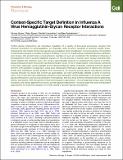Context-Specific Target Definition in Influenza A Virus Hemagglutinin-Glycan Receptor Interactions
Author(s)
Raman, Rahul; Viswanathan, Karthik; Sasisekharan, Ram; Shriver, Zachary H.
DownloadShriver-2009-Context-Specific Tar.pdf (1.847Mb)
PUBLISHER_POLICY
Publisher Policy
Article is made available in accordance with the publisher's policy and may be subject to US copyright law. Please refer to the publisher's site for terms of use.
Terms of use
Metadata
Show full item recordAbstract
Protein-glycan interactions are important regulators of a variety of biological processes, ranging from immune recognition to anticoagulation. An important area of active research is directed toward understanding the role of host cell surface glycans as recognition sites for pathogen protein receptors. Recognition of cell surface glycans is a widely employed strategy for a variety of pathogens, including bacteria, parasites, and viruses. We present here a representative example of such an interaction: the binding of influenza A hemagglutinin (HA) to specific sialylated glycans on the cell surface of human upper airway epithelial cells, which initiates the infection cycle. We detail a generalizable strategy to understand the nature of protein-glycan interactions both structurally and biochemically, using HA as a model system. This strategy combines a top-down approach using available structural information to define important contacts between glycans and HA, with a bottom-up approach using data-mining and informatics approaches to identify the common motifs that distinguish glycan binders from nonbinders. By probing protein-glycan interactions simultaneously through top-down and bottom-up approaches, we can scientifically validate a series of observations. This in turn provides additional confidence and surmounts known challenges in the study of protein-glycan interactions, such as accounting for multivalency, and thus truly defines concepts such as specificity, affinity, and avidity. With the advent of new technologies for glycomics—including glycan arrays, data-mining solutions, and robust algorithms to model protein-glycan interactions—we anticipate that such combination approaches will become tractable for a wide variety of protein-glycan interactions.
Date issued
2009-08Department
Harvard University--MIT Division of Health Sciences and Technology; Massachusetts Institute of Technology. Department of Biological Engineering; Massachusetts Institute of Technology. School of Engineering; Koch Institute for Integrative Cancer Research at MITJournal
Chemistry and Biology
Publisher
Elsevier
Citation
Shriver, Zachary, Rahul Raman, Karthik Viswanathan, and Ram Sasisekharan. “Context-Specific Target Definition in Influenza A Virus Hemagglutinin-Glycan Receptor Interactions.” Chemistry & Biology 16, no. 8 (August 28, 2009): 803–814. © 2009 Elsevier Ltd.
Version: Final published version
ISSN
10745521